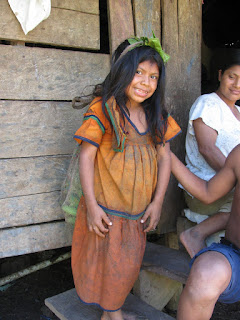Overall, I feel calm, happy, relaxed, content and excited. As I rode along in the little bus today on my way back to my community after a agency meeting, listening to the radio, Panamanian version of yodeling combined with guitar and accordion, swerving down the road, just missing people, bikers, landslides, fallen trees, anteaters, and anything else in the path, I thought to myself how happy I am. I wouldn´t change my decision to come here and have these experiences for anything in the world.
But that is overall.
There are times when I miss home, when I am frustrated, when I am overwhelmed at how hard this is, but that is part of the joy and reward of it all. There are happy times and really hard times.
I have spent my month helping my womens group with organizational and leadership skills, leading a teen youth camp on self confidence, personal development, and sex, HIV and AIDS education. I took 2 teens from my community to the other side of the country for this seminar, kids who had never traveled further than the small town half an hour away from the community. The seminar was held in a beautiful place. When we arrived, we walked the grounds looking at the gardens and the lovely pond, complete with ducks. Upon seeing these duck, the boy traveling with me told me he would like to bring his slingshot to shoot the ducks to eat. I taught the girl to use a flush toilet and helped them have a fabulous time away from home. At the end, neither one wanted to leave and go back home.
Other days I spent working with 17 farmers leading them in constructing their own home gardens and planting rice and corn. I somehow got 17 grown ngabe men to participate playing a few games, giggling like children. Sometimes though, I feel really underqualified when these 17 farmers who have been farming all their lives turn to me and say "Kati, what do we do now?". But we are learning together, making our way. Everyone now has tomatoes, ´peppers, cucumbers, squash and beans growing in their gardens which they look forward to harvesting and eating with their families.
I walk around my community and twirl kids around, humor my neighbors when they tell me silly tales, laughing up a storm. The other day they told me about the Red Chinese that live in glass houses under the sea that eat people of the ngabe race ( I think this corresponds to a historic tale of a submarine appearing in the mouth of a really large river sometime in the 1940s). They asked me if I would fight a red chinese if they came chasing after me. I told them i would be too scared and would just have to run and hide in the bushes. They told me they would join me. They then, and now every day since, have asked me to give the example of how I would run hysterically into the bushes. And I humor them, running hysterically into the bushes.
I am learning so much here. My most recent lessons have been in Ngabe culture. My new neighbors practice a traditional religion called Mama Tata. Cacao is a crucial part of this religion. Whenever needed, my neighbors ask the local shaman to grant the right to have a 4 day celebration . They drink cacao (Hot chocolate, but without milk or sugar, just dark) from a big pot in the center of the room with a gourd cup, from 7pm till 12pm for 4 days straight. They put up special plants as an entrance to the house and burn termite nests to fend off bad spirits and wish for good health.
But unfortunately, good health isnt always to be found. Most children here are malnourished, not starving, just not getting enough of the right nutrients that growing kids need. Sunday, a man asked to borrow my hand grinder to grind up some food for his sick daughter. He then asked me to give him money to buy vitamins for his daughter. But everyone here asks me for money, or salt, or sugar, or whatever they come up with. And I just can{t always hadn out things, because it isnt sustainable and will not help them into the future. It doesnt change anything, it is only a temporary remedy and often times the money is just wasted anyways. So I lent him my grinder and we compromised on me visiting on thursday to see what kind of sickness she had. She died on tuesday, at age 2 of malnutrition. All I could do on thursday was console a crying devestated dad who has now lost three children to malnutrition. It was too late to ask for help, but that doesnt mean that I didnt cry too.
These are the hardest things I will ever face. I almost feel like I am being unfair sharing these sad stories, since it breaks my heart, but it has to be known that it isnt all pink clouds and candy gum drops here. Oh what those kids would do for gum drops to be falling from the sky.Oh but their poor little rotting teeth.
Little by little here, working for the future.













































